七年级下册英语作业:unit10学案、阅读
- 格式:docx
- 大小:22.72 KB
- 文档页数:7
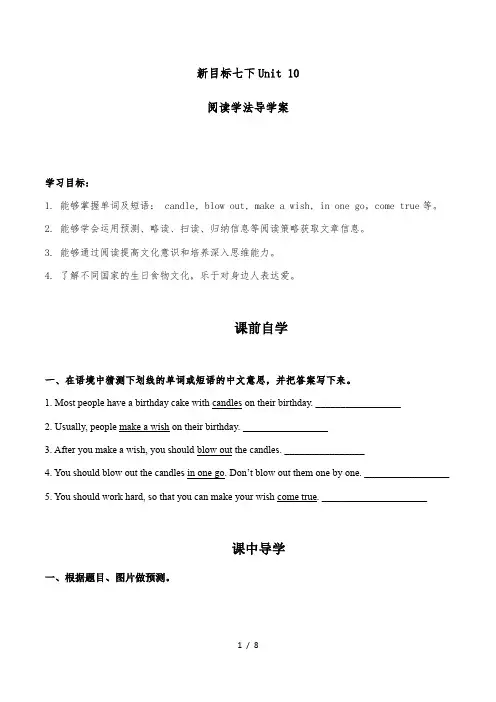
新目标七下Unit 10阅读学法导学案学习目标:1. 能够掌握单词及短语: candle, blow out, make a wish, in one go,come true等。
2.能够学会运用预测、略读、扫读、归纳信息等阅读策略获取文章信息。
3.能够通过阅读提高文化意识和培养深入思维能力。
4. 了解不同国家的生日食物文化,乐于对身边人表达爱。
课前自学一、在语境中猜测下划线的单词或短语的中文意思,并把答案写下来。
1. Most people have a birthday cake with candles on their birthday. _________________2. Usually, people make a wish on their birthday. _________________3. After you make a wish, you should blow out the candles. ________________4. You should blow out the candles in one go. Don’t blow out them one by one. _________________5. You should work hard, so that you can make your wish come true. _____________________课中导学一、根据题目、图片做预测。
1. What is the article mainly about?______________________________________________________________________2. How old is the girl?______________________________________________________________________二、运用略读策略,选择段落大意。
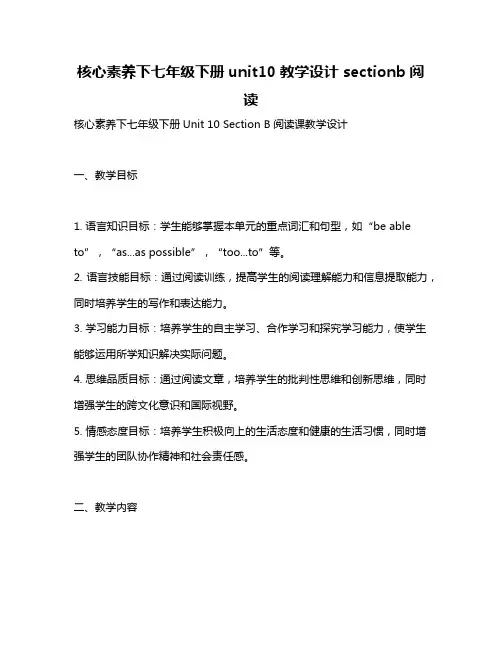
核心素养下七年级下册unit10教学设计 sectionb阅读核心素养下七年级下册Unit 10 Section B阅读课教学设计一、教学目标1. 语言知识目标:学生能够掌握本单元的重点词汇和句型,如“be able to”,“as...as possible”,“too...to”等。
2. 语言技能目标:通过阅读训练,提高学生的阅读理解能力和信息提取能力,同时培养学生的写作和表达能力。
3. 学习能力目标:培养学生的自主学习、合作学习和探究学习能力,使学生能够运用所学知识解决实际问题。
4. 思维品质目标:通过阅读文章,培养学生的批判性思维和创新思维,同时增强学生的跨文化意识和国际视野。
5. 情感态度目标:培养学生积极向上的生活态度和健康的生活习惯,同时增强学生的团队协作精神和社会责任感。
二、教学内容本节课的教学内容为七年级下册Unit 10 Section B的阅读文章“The Greatest Invention of My Generation”。
文章主要讲述了作者认为自己这一代人最伟大的发明是什么,以及为什么这么认为。
文章中涉及了一些现代科技的发展和应用,如智能手机、互联网等。
三、教学步骤1. 导入:通过提问导入本节课的主题,如“What do you think is the greatest invention of the 21st century?”,引导学生思考现代科技的发展和影响。
2. 词汇讲解:通过实物、图片等形式讲解本节课的重点词汇,如“smartphone”,“Internet”,“invent”,“generation”等,帮助学生扫清阅读障碍。
3. 阅读理解:让学生先快速阅读文章,了解文章的大意和结构,然后通过细节阅读和问题回答等方式,引导学生深入理解文章内容,培养学生的阅读理解能力和信息提取能力。
4. 语言运用:通过小组讨论、角色扮演等形式,让学生运用所学知识进行口语表达和写作练习,培养学生的语言运用能力和跨文化交际能力。
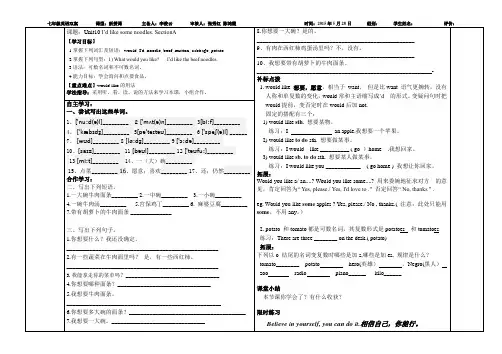
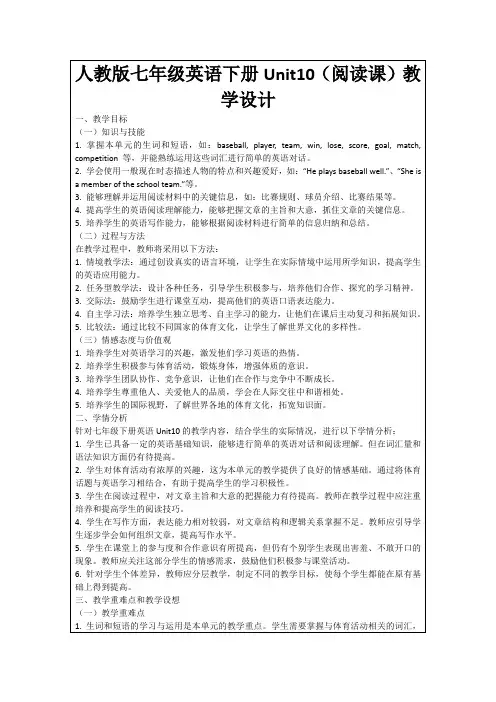
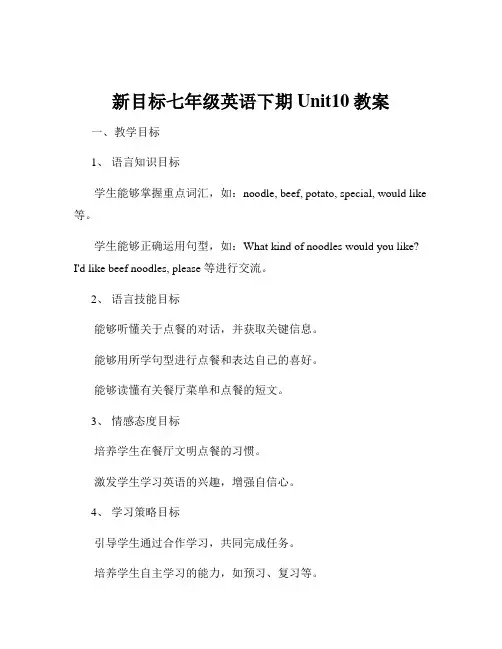
新目标七年级英语下期Unit10教案一、教学目标1、语言知识目标学生能够掌握重点词汇,如:noodle, beef, potato, special, would like 等。
学生能够正确运用句型,如:What kind of noodles would you like? I'd like beef noodles, please 等进行交流。
2、语言技能目标能够听懂关于点餐的对话,并获取关键信息。
能够用所学句型进行点餐和表达自己的喜好。
能够读懂有关餐厅菜单和点餐的短文。
3、情感态度目标培养学生在餐厅文明点餐的习惯。
激发学生学习英语的兴趣,增强自信心。
4、学习策略目标引导学生通过合作学习,共同完成任务。
培养学生自主学习的能力,如预习、复习等。
二、教学重难点1、教学重点重点词汇和句型的掌握与运用。
能够听懂并进行关于点餐的对话。
2、教学难点特殊疑问句 What kind of noodles would you like? 及其回答的正确运用。
区分不同种类的面条和食物的英文表达。
三、教学方法1、情景教学法通过创设餐厅点餐的情景,让学生在真实的语境中学习和运用语言。
2、任务驱动法布置各种任务,如小组对话、角色扮演等,让学生在完成任务的过程中提高语言能力。
3、游戏教学法通过单词游戏、句型游戏等,增加学习的趣味性,提高学生的参与度。
四、教学过程1、导入(Leadin)展示一些美食的图片,如面条、牛肉、土豆等,问学生是否喜欢这些食物,引出本节课的主题——餐厅点餐。
2、词汇学习(Vocabulary Learning)展示图片,教授新单词,如 noodle, beef, potato, special 等,让学生跟读、拼写。
通过单词游戏,如猜单词、单词接龙等,巩固所学单词。
3、句型学习(Sentence Pattern Learning)呈现句型 What kind of noodles would you like? I'd like beef noodles, please 讲解句型结构和用法。
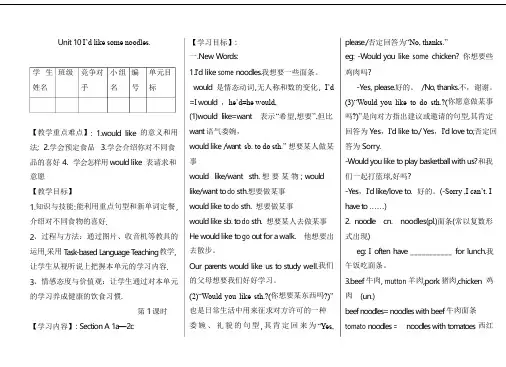
Unit10I’d like some noodles.【学习目标】:一.New Words:please./否定回答为“No,thanks.”eg:-Would you like some chicken?你想要些学生班级竞争对小组编单元目 1.I'd like some noodles.我想要一些面条。
鸡肉吗?姓名手名号标would是情态动词,无人称和数的变化,I’d-Y es,please.好的。
/No,thanks.不,谢谢。
【教学重点难点】: 1.would like的意义和用法; 2.学会预定食品 3.学会介绍你对不同食品的喜好4.学会怎样用would like表请求和意愿【教学目标】1.知识与技能:能利用重点句型和新单词定餐,介绍对不同食物的喜好.2、过程与方法:通过图片、收音机等教具的运用,采用T ask-based Language T eaching教学,让学生从视听说上把握本单元的学习内容.3、情感态度与价值观:让学生通过对本单元的学习养成健康的饮食习惯.第1课时【学习内容】:Section A1a—2c =I would,he’d=he would,(1)would like=want表示“希望,想要”,但比want语气委婉,would like/want sb.to do sth.”想要某人做某事would like/want sth.想要某物;wouldlike/want t o do sth.想要做某事would like t o do sth.想要做某事would like sb.t o do sth.想要某人去做某事He would like t o go o u t for a walk.他想要出去散步。
Our parents would like us t o study well.我们的父母想要我们好好学习。
(2)“Would you like sth.?(你想要某东西吗?)”也是日常生活中用来征求对方许可的一种委婉、礼貌的句型,其肯定回来为“Yes,(3)“Would you like to do sth.?(你愿意做某事吗?)”是向对方指出建议或邀请的句型,其肯定回答为Yes,I'd like to./Yes,I'd love to;否定回答为Sorry.-Would you like t o play basketball with us?和我们一起打篮球,好吗?-Y es,I'd like/love to.好的。

Unit10 I’d like some noodles.单元话题: 学会如何订餐或叫外卖。
能够听懂、读懂以食物为话题的英文材料。
能以书面表达的形式描述自己或他人喜欢的食物种类等。
熟悉东西方就餐文化差异。
重点短语:would like, one blow of, around the world, make a wish, get popular, cut up, bring luck to,in different countries, make a wish, bring good luck to take one's order 意为“点菜”,如:May I take your order? 您现在可以点菜吗?what size 意为“多大尺码”, 如:What size is your jacket? 你的夹克衫是多大尺码?the number of “...的数量”,后跟可数名词复数,作句子主语时,谓语动词用单数。
如:The number of the students is 50. 学生数是50。
a number of “许多”,修饰的是名词复数,做主语时,谓语动词用复数。
如:A number of students walk to school. 许多学生步行去上学。
or: 1. 用于肯定句,意为“或者”。
如:She has a twin sister or brother.2.用于选择疑问句,意为“或;还是”。
如:Does your mother has straightor curly hair?3.用于“祈使句+or ”, 表示“否则”。
如:Hurry up, or you will be late. 重点句型:1. What would you like?2. ---What kind of noodles would you like?---I’d like beef noodles, please?3. ---What size would you like?---Large, please.4. ---May I take your order?---Yes. Is there any meat in the tomato and egg soup?5. ---Would you like a medium bowl?---Yes, please./ No, thanks.6.The answer would be different in different countries.7.The number of candles is the person’s age.8.They can bring good luck to you.9.How can a person make his or her birthday wish come true?单元语法:would like 的用法would like 意为“想要......”, 与want 同义,但语气更加委婉。
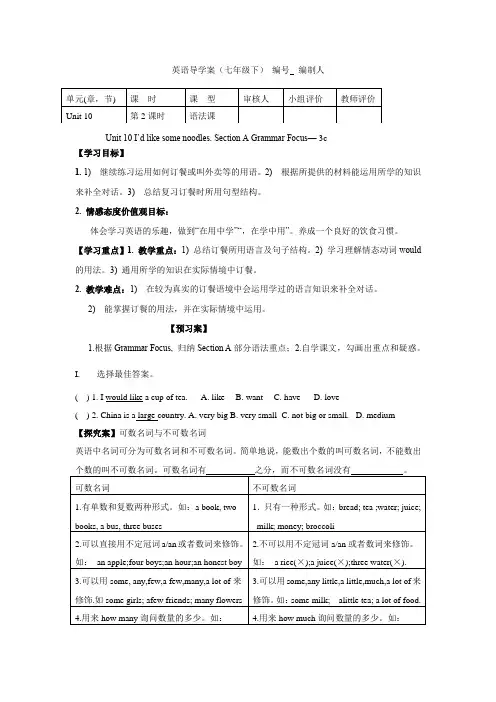
英语导学案(七年级下)编号编制人【学习目标】1. 1) 继续练习运用如何订餐或叫外卖等的用语。
2) 根据所提供的材料能运用所学的知识来补全对话。
3) 总结复习订餐时所用句型结构。
2. 情感态度价值观目标:体会学习英语的乐趣,做到“在用中学”“,在学中用”。
养成一个良好的饮食习惯。
【学习重点】1. 教学重点:1) 总结订餐所用语言及句子结构。
2) 学习理解情态动词would 的用法。
3) 通用所学的知识在实际情境中订餐。
2. 教学难点:1) 在较为真实的订餐语境中会运用学过的语言知识来补全对话。
2) 能掌握订餐的用法,并在实际情境中运用。
【预习案】1.根据Grammar Focus, 归纳Section A部分语法重点;2.自学课文,勾画出重点和疑惑。
I.选择最佳答案。
【快乐链接】 Riddle (谜语) --- 打食物名1.What kind of dog doesn’t bite or bark?--- _______________2.What is the smallest room in the world?---3.What table is in the field?--- _______________4.What stays hot even if put it in a fridge?---pepper5.What is the only vegetable that will make you cry?--- _______________6. My first letter is in "tea", not in "sea". My second letter is in "those", not in "these" My third letter is in "fine", not in "nine" My forth letter is in "buy", not in"boy". ---。
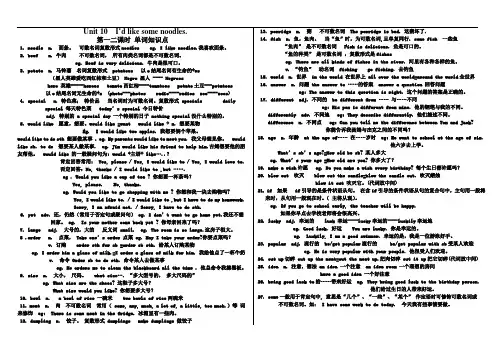
Unit 10 I’d like some noodles.第三四课时单词知识点some 用于疑问句时,表示建议、请求或希望得到肯定回答。
如:Would you like some coffee with sugar?你要加糖的咖啡吗?any 一般用于疑问句或否定句中, 意思是“任何一些”、“任何一个”, 作定语时可修饰可数或不可数名词。
如:They didn’t have any friends he re.他们在这里没有朋友。
any 用于肯定句时,意思是“任何的”. Eg. Come here with any friend. 随便带什么朋友吧。
28. the number of …….的数量。
后接复数名词,中心词为number,因此该短语主语时,谓语动词用单数。
eg. The number of students in our school is more than six thousand.我们学校学生数是6000多。
A number of许多的……. 。
做主语时,谓语动词用复数形式。
eg: A number of students in our school are friendly. 我们学校很多学生是友好的。
29. 名词:可数名词与不可数名词A、不可数名词,初中阶段常见的不可数名词有:water ; meat ; rice ; bread ; milk ; tea ;orange(桔汁) ; fruit ; air ; snow ; chalk; work ; paper(纸) ; time(时间); music ; weather ;grass ; news ; food ; fish(鱼肉); coke ; porridge ; cake(可数或不可数). 不可数名词应注意以下几点:1)前无数、冠,后无复数;作主语为三单.2)表量用约数some /any ; much ; a lot of 或用of短语eg. There is ____ bread on the table. [C]A. aB. oneC. a piece ofD. manyThere is some_______ on the plate. [B]A. appleB. fishC. milksD. deer2、可数名词的复数:A、不规则变化:man—men ; woman—women ;child—childrenpoliceman—policemenEnglishman—EnglishmenFrenchman—Frenchmenfoot—feet ; tooth—teeth mouse(鼠)—miceB、规则变化1)s; sh; ch; x 结尾加 es 读 [iz]2) ce; se; ze; (d)ge 结尾加 seg. boxes [b ksiz] blouses [blauziz]3)f (fe) 结尾则变f(fe)为v加es---读[vz]eg. knives [naivz] 4) “辅+y”结尾变y为i加es 清就清[s]5)一般加s 浊就浊[z]eg. books[buks] pens[penz] babies[beibiz]但注意以下几点:① potato—potatoes ; tomato—tomatoes②单复同形: fish ; sheep ; deer ; Chinese ; Japanese③由man , woman在词首构成的复合名词应将两部分都变成复数man doctor — men doctors④ reef—reefs⑤“某国人”的复数:中日不变英法变,其余s加后面. eg. German—Germans⑥ people , police 常用单数形式表示复数概念.eg. The police are looking for the missing boy.3、名词所有格:名词’s (意思是“……的”)A.有生命的名词所有格,一般在后加“’s”但注意:1)表两者共有则在后者加“’s”Lucy and Lily’s father 露西和莉莉的父亲Luc y’s and Lily’s fathers露西的父亲和莉莉的父亲.2)以s结尾的词只加“ ’ ”eg. 1) the boys’ books 2) James’ father3)无生命的名词所有格用of来引导eg. the leg of the desk4)双重所有格:a friend of my father’sa friend of mine ( √ ) a friend of my( × )练习:一、写出下列词的复数1.book______2.bus ____ __3.orange ___ ____4.baby__ ____5.boy__ ____6.my ____ ____7.his__ _____8.knife____ __9.watch______ __10.sheep ___ ___ 11. tooth __ ___12. leaf ___ _13.German___ _______ 14.Chinese_____ ____Unit 10 I’d like some noodles.orUnit 10 I’d like some noodles.自测一第十三课时一.根据首字母或汉语提示,写出单词。
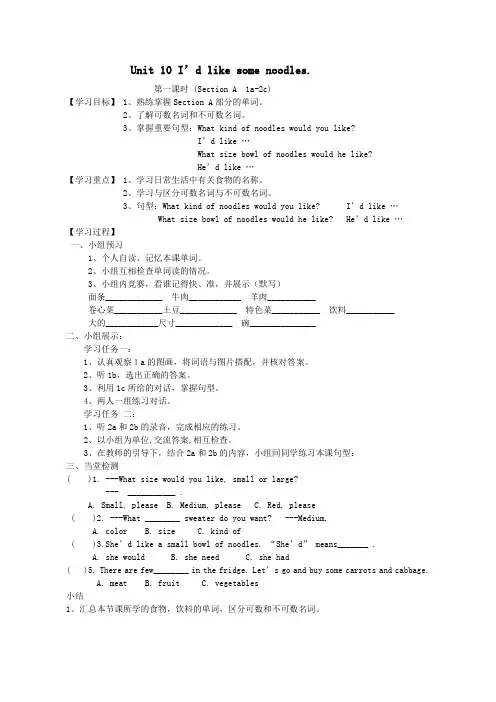
Unit 10 I’d like some noodles.第一课时 (Section A 1a-2c)【学习目标】 1、熟练掌握Section A部分的单词。
2、了解可数名词和不可数名词。
3、掌握重要句型:What kind of noodles would you like?I’d like …What size bowl of noodles would he like?He’d like …【学习重点】 1、学习日常生活中有关食物的名称。
2、学习与区分可数名词与不可数名词。
3、句型:What kind of noodles would you like? I’d like …What size bowl of noodles would he like? He’d like …【学习过程】一、小组预习1、个人自读、记忆本课单词。
2、小组互相检查单词读的情况。
3、小组内竞赛,看谁记得快、准,并展示(默写)面条_____________ 牛肉____________ 羊肉___________卷心菜___________土豆_____________ 特色菜___________ 饮料___________大的____________尺寸_____________ 碗_______________二、小组展示:学习任务一:1、认真观察1a的图画,将词语与图片搭配,并核对答案。
2、听1b,选出正确的答案。
3、利用1c所给的对话,掌握句型。
4、两人一组练习对话。
学习任务二:1、听2a和2b的录音,完成相应的练习。
2、以小组为单位,交流答案,相互检查。
3、在教师的引导下,结合2a和2b的内容,小组间同学练习本课句型:三、当堂检测( )1. ---What size would you like, small or large?--- ___________ .A. Small, pleaseB. Medium, pleaseC. Red, please( )2. ---What ________ sweater do you want? ---Medium.A. colorB. sizeC. kind of( )3.She’d like a smal l bowl of noodles. “She’d” means_______ .A. she wouldB. she needC. she had( )5. There are few________ in the fridge. L et’s go and buy some carrots and cabbage.A. meatB. fruitC. vegetables小结1、汇总本节课所学的食物,饮料的单词,区分可数和不可数名词。
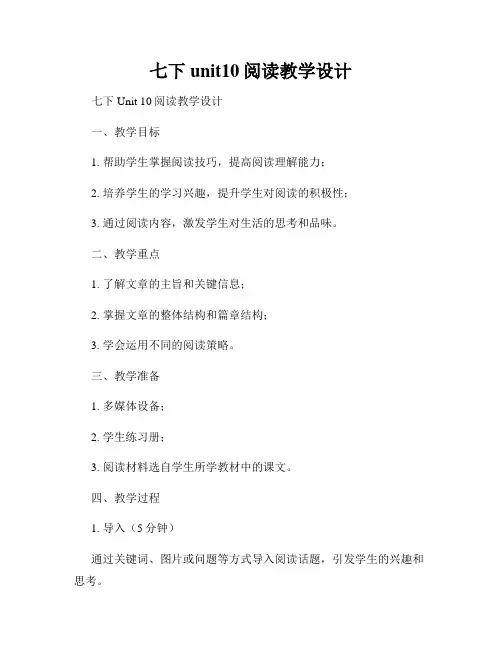
七下unit10阅读教学设计七下Unit 10阅读教学设计一、教学目标1. 帮助学生掌握阅读技巧,提高阅读理解能力;2. 培养学生的学习兴趣,提升学生对阅读的积极性;3. 通过阅读内容,激发学生对生活的思考和品味。
二、教学重点1. 了解文章的主旨和关键信息;2. 掌握文章的整体结构和篇章结构;3. 学会运用不同的阅读策略。
三、教学准备1. 多媒体设备;2. 学生练习册;3. 阅读材料选自学生所学教材中的课文。
四、教学过程1. 导入(5分钟)通过关键词、图片或问题等方式导入阅读话题,引发学生的兴趣和思考。
2. 预测与问题提出(10分钟)提出一系列问题,让学生预测文章内容,并根据问题的要求培养学生获取信息的能力和提出问题的能力。
3. 阅读与答案解析(30分钟)学生阅读课文,根据所掌握的阅读技巧和策略,有针对性地获取信息,并解答老师提出的问题。
老师在这个过程中可以适时提供必要的提示和指导。
4. 分组合作(15分钟)将学生分成小组,要求每个小组成员根据自己的角色与任务进行合作,讨论并整理所获得的信息。
鼓励学生发表自己的观点,提高表达能力。
5. 学业延伸(10分钟)提供一些与文章相关的额外阅读材料,供学生自愿阅读,进一步拓展他们的知识面。
6. 总结归纳(5分钟)对本节课的教学内容进行总结,帮助学生复习和巩固所学知识。
五、教学延伸1. 阅读材料可根据教材内容适度调整,增加一些生活实例或文化背景,以增强学生的阅读兴趣和理解能力;2. 可以进行一些与文章主题相关的讨论活动,激发学生的思维和表达能力;3. 可以通过与其他科目的连线,扩展阅读教学的应用领域。
六、教学反思本节课通过多种阅读策略和教学手段,使学生在主动参与的过程中提高了阅读理解能力。
同时,引导学生进行合作学习,培养了团队合作精神和交流能力。
通过阅读文本,学生可以进一步了解和思考生活中的问题和现象,提高他们的思辨和应变能力。
在今后的教学中,我将更加注重培养学生的阅读兴趣和阅读能力,使阅读教学更加有效和有趣。
人教版七下英语第10单元教案及反思第10单元教案:Taking Care of the Environment一、教学目标:1. 掌握并运用以下词汇:environment, pollution, recycle, reduce, reuse, waste, plastic, container, throw away, throwout2. 能够听懂并能准确回答与环境保护相关的问题。
3. 能够就环保问题陈述自己的意见并能够与他人进行简单的讨论。
4. 培养良好的环保意识,积极参与到环保活动中。
二、教学重难点:1. 掌握并能够准确运用新学词汇。
2. 能够就环保问题展开简单的讨论。
3. 培养学生的环保意识,激发学生参与环保活动的积极性。
三、教学方法:1. 情景导入法:以图片和问题引入新课内容,激发学生的学习兴趣。
2. 合作学习法:通过小组活动、讨论等方式,让学生之间相互交流,培养学生的表达能力。
3. 听说读写综合训练:通过听力、口语、阅读、写作等方式全方位地训练学生的语言能力。
四、教学过程:Step 1: 情景导入(5分钟)1. 让学生看一些与环保相关的图片,并引导他们回答以下问题:a. 你们觉得环保是什么意思?b. 为什么我们要保护环境?c. 你们知道有哪些环境问题?Step 2: 自主学习(15分钟)1. 听录音,跟读课文并尝试回答问题。
2. 阅读课文,找出并圈出新学词汇。
3. 团队合作:分组讨论,根据课文内容回答一些问题。
4. 给学生分发课文,并让他们试着模仿课文中的句子,进行角色扮演。
Step 3: 合作交流(10分钟)1. 让学生分组,选择一个环保问题,进行小组讨论,并准备一份短文或海报来呼吁大家共同保护环境。
2. 每组派代表发表自己的观点,其他组员进行提问和讨论。
Step 4: 知识巩固(15分钟)1. 进行听力训练,让学生听录音并选择正确的答案。
2. 通过阅读环保文章巩固学习的词汇和句型,进行阅读理解练习。
七年级英语Unit10 I’d like some noodles.导学案学习目标1. 通过理解文章,完成表格及回答问题,了解世界各国的人们过生日时的习俗。
上课时间审核领导岳朝军教与学的过程思考、点拨、小结自主学习自我检测(10分)一.写出自己生日时做什么,吃什么,并展示:On my birthday, I ..., I eat ...二.读短文完成2b填空。
三.再读短文,回答问题。
四.翻译下列句子或短语。
1.全世界__________________________2. 吃有蜡烛的生日蛋糕________________________________________3. ...的数目__________________________4. 许愿____________________________5. 一口气_____________________________6. 受欢迎___________________________________7.一种长寿的象征__________________________8.为寿星带来好运_____________________________下列短语会帮助你理解课文,你能写出来么?1. 生日蛋糕2. 吹蜡烛3. symbol4. cut up5. birt hday person合作交流组内互测(10分)小组交流文章中不理解的内容。
四、盘点收获(课后)2分钟展示解疑点拨提升(10分)读句子,总结the number of和a number of的区别;number of the students in our class is 54.number of her story books is 20.number of students go to the zoo today.number of story books are in the school library.总结:the number of 意思是__________,a number of 意思是__________,这两个短语后面都可以跟名词复数,但区别是,the number of +复数名词做主语时,谓语动词用__________形式,a number of +复数名词做主语时,谓语动词用__________形式.巩固训练、当堂检测:(每小题5分,满分100)分数:___________II.阅读下面的有关过生日的文章。
教学设计I. The analysis of the teaching material students.The text comes from the second book of Go for it. It is from Section A of Unit 10. It is a reading class. The students’ reading skills are not so good. Some of them even are afraid of reading. I want to improve students’ reading skills and make them have interest in English reading. The topic is very interesting, so I think it will be very easy to arouse the students’ interest.II. Teaching objects.Knowledge objects: 1. Students can learn new words and phrases.2. Students can understand the main idea of the text.“the number of”, “cut up”,3. Students can master how to use“a symbol of”Ability objects: 1. Students can skim for the main idea of the text and scan for specific information.2. Arouse students’ interest in English learning.III. Key points and difficult pointsKey points: 1. To get an overall understanding of the whole text.2. To develop their reading skills such as skimming and scanning.3. The usage of “the number of”, “cut up”, “a symbol of”Difficult points: 1. to develop the ability of skimming and scanning.2. to master the usage of “the number of”.IV. Teaching methods and teaching aids1. Tasked-based teaching method2. Audio-visual teaching method3. Situational teaching methodTeaching aids: a computer and a blackboardV. Teaching procedures(the whole class is divided into five groups)Step one warming up activity (pre-reading)I will have a birthday party next week, but I didn’t do or buy anything for my birthday party. Can you help me think about it? The students have one minute to discuss with their group members. After their discussion, I will choose one studentfrom every group. They have to say their answers in ten seconds. The group which shows the most answers will get two stars. The group which shows the second most will get one star. Then I will show some words which are related to birthday party. Then I will move out the words which are not birthday food, and then lead into the topic of this text—Birthday Food around the World. I use situational teaching method.Step two (while-reading)Activity one Fast readingThe students will have two minutes to read the passage and get the main idea of the passage. In this part, I want to practice the students’ skimming skills. I use audio-visual teaching method in this part.Activity two Do you know them?I will show two pieces of videos. After watching them, students need to finish the chart below the text. I use audio-visual teaching method in this part.Activity three Careful readingThe students will listen to the text and read the text at the same time. After reading, the students have to close their books. After that, I have six questions about the content of the text. When I say: “one, two, three, go”, the first student who raise his/ her hand will have the chance to answer my question. If he/she answers the question correctly, he/she will get one star for his group.1.Do people all over the world like to eat the same food on their birthday?A. Yes, they do.B. No, they don’t.2. My daughter is three years old, so how many candles will she have?Three candles.3. How can a person make his or her birthday wish come true?He or she blows out all the candles in one go.4. What do people in the UK sometimes put in a birthday cake?A. A candy.B. A coin(硬币).5. Why do people never cut up birthday noodles in China?A. Because it’s delicious.B. Because it’s a symbol of long life.6. Why do people eat special foods on their birthday?A. Because they bring good luck to the birthday person.B. Because they like the food.Step three post-readingActivity one Who is the luckiest one? (Play a game)ts, if you do different tasks. There is one Every picture is a task. You’ll get different poinpicture which is the luckiest one. That is to say, you don’t have to do anything to get the points. I want to arouse students’ learning interest and consolidate the language points in thistext through this game.Activity two fill in the blanksFill in the blanks in the ad with the words in the box.Would you like to eat ice-cream or pancakes? At our restaurant, we have some greatspecials. We have different kinds of fruit ice-cream, like strawberry, banana or orange.Would you like a big bowl for four yuan or a small one for just two yuan? You can also orderour delicious pancakes. They are only five yuan.This activity will not only help students consolidate the knowledge in this text, but also behelpful for the next activity—writing.Step four consolidation Can you write an ad for my cake house?In this part, the students need to write a composition according to the given information. Iwill tell the students: I have a cake house; I need them to write an ad for my cake house,because there are only a few people know my cake house.Would you like to eat birthday cakes? We have many kinds of birthday cakes. We have alarge birthday cake for 108 yuan . The medium one is 88 yuan. The small one is very cheap.It’s only 68. They are very delicious. You will love them if you have a try. Welcome toCindy’s Cake House.Step five homeworkDraw a poster for me according to your ad.VI. Teaching evaluationThe students were interested in this class, and they have understood the whole text clearly.From their writing, we can know that they have mastered how to write an ad in English andall language points. So we finish our teaching objectives.。
* 教师寄语:An apple a day keeps the doctor away. 一天一苹果,医生远离我。
【学习目标】【学习重点】:1、学习常用食物词汇;2、学会如何预定食物。
--What would you like? -- I’d like some…./I’m not sure yet.【体验学习】:I、预习交流1.根据单元标题和图片等,预测新课内容;2.根据音标拼读单词并牢记;3.自学课文,勾画出重点和疑惑。
II、翻译官1. 想要,喜欢_________________2. 牛肉面____________________ 4. 鸡肉_____________________ 5. 羊肉______________________3. 卷心菜___________________ 6.胡萝卜_____________________ 7. 土豆(复数) _______________ 8. 西红柿(复数) _______________ 9. special ___________________ 10. 我还没想好。
_______________ 【课堂导学】:I、新课呈现Step1 Brainstorming(头脑风暴)Try to speak out the names of food you know.Step2 Presentation1.Learn the new words about food in 1a.2.Finish 1a, then check the answers.3.Look at the picture in 1a and learn the drills:--What would you like? -- I’d like some….Step3 ListeningListen and finish 1b. Check the answers.Step4 Pair workPractice the conversations in 1a .Then make your own conversations.II、合作交流Gr oup work: 分析总结如何预定食物,并练习造句。
青铜峡市第五中学七年级下英语讲学案Unit10 I ' like some noodles. (section A 1a-1c )青铜峡市第五中学七年级下册英语讲学案七下英语10单元学案Unit10 I ' like some noodles.Imagine now we are in a Nooodle House1. Ask some stude nts to an swer the questi ons. The teacher writes the an swers on the blackboard.A: What kind of noodles would you like? / Would you like beef noodles?B: I ' d like beef and tomato noodle/sYes, please. / NO, thanks.三、互学(课中)1. Pairwork:你和你的家人喜欢什么样口味的面条,回答下列问题。
What kind of no odles would you like? ____________________________________What kind of no odles would your father like? __________________________________What kind of no odles would your mother like? _________________________________2?认真观察2a的图画,回答问题What kind of no odles can you see in the picture?1.听录音完成2a,核对答案,听录音完成2b对话3 .根据2a中的信息两人一组完成对话,完成2c四、测学(课后)(教师寄语:相信自己,永不言弃.)调查调查班级同学喜欢什么口味的面条,以及什么型号,完成下表Model: A: What kind of noodles would you like? B: I dlike __________ noodles.A: What size bowl of no odles would you like?B: I d like a _____ b owl of noodles.根据你所调查的内容完成一个调查报告,并翻译句子My friend _________ is a student, he would like ___________________ , He would like a____ bowl of ________ no odles.1. 我想要一大碗面。
Unit 10 I'd like some noodles课文重难点讲解【教师寄语】:You have to believe in yourself. That's the secret of success.• 人必须有自信,这是成功的秘密。
Section A1. I'd like some noodles【解析1】would v情态动词,表示意愿would like =want 想要(1) would like sth =want sth 想要某物I’d like some water now.(2) would like to do sth =want to do sth想去做某事I’d like to go swimming this weekend.(3) would like sb. to do sth=want sb. to do sth 想要某人去做某事She’d like me to help her .【解析2】—Would you like sth? 你想要什么吗?(用于有礼貌地、语气委婉地征求对方要求的用语)肯定回答:—Yes, please否定回答:—No, thanks—Would you like some coffee?—No,thanks.【解析3】—Would you like to do sth ? 你愿意做某事吗?(用来向对方有礼貌地提出建议或邀请的句型)肯定回答:—Yes, I’d love/like to否定回答:—Sorry, I’m afraid…—Would you like to go shopping with me?—Yes, I’d like to ./ Sorry, I have to do my homework.( )①She’d like ____ tonight.A. going to the moviesB. go to the moviesC. to go to the movies ( )②—Would you like _______ apples? —Yes, please.A. someB. anyC. many( )③—Would you like to eat beef noodles. —No, _________.A. Thank you.B. thanksC. all right.2. What kind of noodles would you like? 你想要哪种面条?【解析1】kind n 种类a kind of 一种的all kinds of 各种各样的different kinds of 不同种类的what kind of 哪种kind of 有几分,有点儿= a little /a bit 后跟形容词The girl is kind of shy.【解析2】What kind of …?用来询问某人需要哪一种物品,后面的名词若是可数名词,常用复数形式,也可跟不可数名词。
What kind of noodles would you like?What kind of movies do you like?3.Can I help you?= What can I do for you?【解析1】用于商店售货员时,意为“你要买点什么?”用于餐厅服务员时,意为“你要吃什么?”用于询问有困难的人时,意为“我可以帮助你吗?”肯定回答:Yes, please . I would like ……否定回答:No, thanks.( ) ___ help you?A. Do IB.I doC. Can ID. Does I4. —What size would you like? 你想要多大碗的?—Medium, please. 中碗的【解析1】What size 多大的,多大尺寸的,用来询问大小、尺码—What size shirt do you want?—I want a large one.【拓展】表示型号大小的词有:Large = L (大号) Medium =M (中号) Small =S (小号)( )①—____ shoes do you wear?—35.A. How longB. What sizeC. How wideD. What color( )②—____ size bowl of noodles would you like?—Large.A. WhyB. WhatC. WhereD. When5. Can we have two bowls of beef soup then? 那我们可以要两碗牛肉汤吗?【解析】“数词+ 量词+of + 名词”two bowls of 两碗a bowl of “一碗……” 后接不可数名词,表示复数时,bowl变为复数即可。
( ) —How many _____ are there in the kitchen?—Only in the kitchen.A. bag of riceB. bags of riceC. bags of rices6. beef and tomato noodles 牛肉西红柿面(1)英语中的名词作定语时通常用单数形式。
a banana tree 一棵香蕉树two boy/girl friends(2)man 和woman 做定语时根据所修饰的名词单复数而变化。
a woman teacher 一个女教师three m e n/wom e n teacher s三个男教师7. potato n “土豆” (pl) photatoes【拓展】以o 结尾的可数名词变复数加-es的词hero – heroes (英雄) Negro –Negroes (黑人)Potato – potatoes (土豆) tomato – tomatoes (西红柿)( ) I like lots of vegetables, such as cabbages, carrots and _____________(西红柿).8. May I take your order? 可以点菜了吗?【解析】order v “预定,点菜“take one’s order 准备点菜单元短语集锦:1.would like 想要would like to do sth \want to do s.th 想要作某事2.beef and tomato noodles 牛肉西红柿面chicken and cabbage noodles mutton and potato noodlestomato and egg noodles beef and carrot noodles3.green tea 绿茶4.a large bowl of … 一大碗的……5. order food 定餐6. give reasons for… 给出…的理由7.what kind of noodles什么种类的面条8.what size bowl of noodles什么大小碗型的面9.a large\medium\small bowl of noodles 大\中\小碗的面10.ice cream冰淇淋orange juice桔汁green tea绿茶RMB人民币phone number11. House of Dumplings\noodles饺子\面馆Dessert House甜点屋一、单项选择( )1.—What size would you like, small or large? —___________ .A. Small, pleaseB. Medium, pleaseC. Red, please( )2. —What ________ sweater do you want? —Medium.A. colorB. sizeC. kind of( )3.She’d like a small bowl of noodles. “She’d” means_______ .A. she wouldB. she needC. she had( )5. There are few________ in the fridge. Let’s go and buy some carrots and cabbage.A. meatB. fruitC. vegetables( ) 6. She’d _______________ some beef noodles for lunch.A. likesB. likeC. haveD. has( ) 7. Would you like some ____________________?A. apples juiceB. apple juicesC. apple juiceD. apples juices( ) 8. There ____________________ in the large bowls.A. are some ricesB. is some riceC. has some eggsD. have some noodles( ) 9. Two glasses of orange juice _____________ on the table.A. areB. isC. haveD. has( )10. —Would you like green tea __ juice? —I don’t like green tea _____ juice.A. and, andB. or, orC. and, orD. or, and单元语法总结情态动词would 与can, may, must, need 的用法相同,不能单独做谓语,要与动词原形共同构成谓语,情态动词would无人称和数的变化。
常与主语缩写成I’d, he’d we’d 等形式I’d like ________(e at ) bananas ,(一) 含情态动词would的肯定句结构:主语+would+动词原形+其它I would like to go with you.(二) 含情态动词would的否定句结构:主语+would+ not+动词原形+ 其它He would not play the piano every day.(三)含情态动词would的一般疑问句Would +主语+动词原形+其它?—Would you like to play soccer with us?—Yes, I’d love to.(四)含情态动词would的特殊疑问句—What would you like to do?—I would like to play chess with you.( ) 1.—Would you like something to drink?—________,please.A. MeatB. RiceC. WaterD. Bread( ) 2.—Would you like some more tea?—______ .please.A. No moreB. Just a littleC. I’ve had enoughD. Yes,I would ( ) 3.—Would you like to come to the party tonight?—Yes,______A.I would beB.I likeC.I doD. I’d like to( ) 4.Would you like _______a rest?A. haveB. to haveC. hasD. having( ) 5.—Would you like something to eat?—______A. Yes ,pleaseB. Not at allC. No, just a littleD. Thank you练习;I.用所给词的正确形式填空1.I’d like_________ ( go) swimming now.2.They want to buy some_________(potato).3.Many Americans like _________(China) food .4.There __________ (be) some chicken and eggs on the refrigerator(冰箱).5.How much _______(be) two bowls of noodles?6.I would like some________(beef).7.Would he like _________(buy) that hat?8.Kathy wants ________(eat) dinner with her family.9.I like to eat _________(Potato) but I don’t like _________(potato) soup.10.Do you like ___________(strawberry)?II.选择题( ) 1.—_____? —Yes, I’d like a hamburger.A. Can you help meB. Can I help youC. Do you like hamburger sD. What do you like( ) 2.—Would you like some milk? —______.A. Yes, I wouldB. No, I wouldn’tC. Yes, I likeD. Yes ,please( ) 3.I’d like ____ a cup of coffee with sugar.A. haveB. eatC. drinkD. to have()4.—I’d like some oranges. —_______.A.OK ,here you areB. Here they areC. It’s hereD. Here are you()5.She’d like ______ volleyball on Sunday.A. playsB. playC. playingD. to play阅读下面短文,从各小题所给的四个选项中选出能够回答所提问题或完成所给句子的最佳答案。